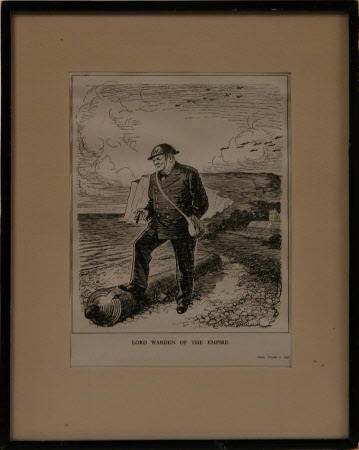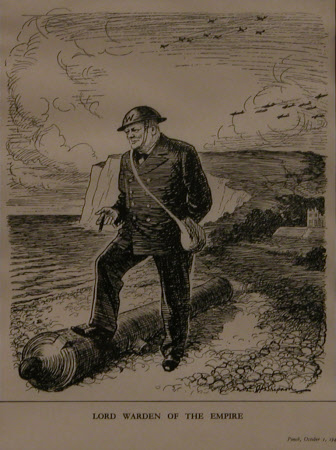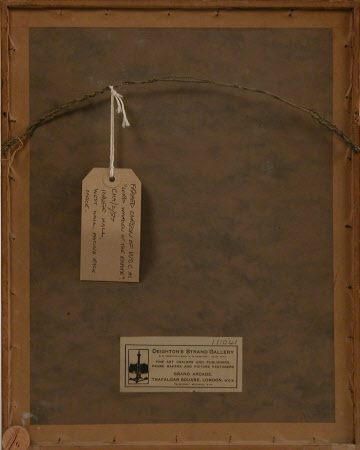Sir Winston Churchill (1874 - 1965) as 'Lord Warden of the Empire'
Ernest Howard Shepard (St John's Wood 1879 - Midhurst 1976)
Category
Art / Prints
Date
Unknown
Materials
Paper
Measurements
372 x 297 x 21 mm
Place of origin
England
Order this imageCollection
Chartwell, Kent
NT 1100054
Summary
Print, cartoon, Sir Winston Churchill (1874 - 1965) as 'Lord Warden of the Empire' by Ernest Howard Shepard (St John's Wood 1879 - Midhurst 1976). A reproduction of E.H. Shepherd's caricature of WSC as "Lord Warden of the Empire" originally published in 'Punch' 1st October 1943. Winston Churchill the air raid warden stands guard at the cliffs of Dover, one foot on a cannon with Spitfires overhead.
Full description
The phrase below the cartoon is a play on the term ‘Lord Warden of the Cinque Ports’, an honour held from 1941 till 1965. Churchill was installed on the 14th August 1946, by King George VI, at Buckingham Palace. Images above of Churchill in official uniform and inspecting the troops at Dover Castle. Cinque Ports: Originally, the Cinque Ports (pronounced 'Sink' Ports) were a confederation of five harbours, Sandwich, Romney, Dover, Hythe, and Hastings plus the two Ancient Towns of Rye & Winchelsea. These were grouped together, for defence purposes, by Edward the Confessor. They supplied the Crown with ships and men. In early times, the fishing fleets, maintained by the South Eastern coastal towns were frequently pressed into service to convey people, and armies, to and from the Continent, as well as to fight battles at sea. They formed the first Navy, and, in return for the use of their vessels, the ports received many privileges from the Crown. Gradually the ports grouped together for mutual support and a confederation of the five main ones, Sandwich, Dover, Hythe, Romney, and Hastings, was formed and became known as the Cinque Ports. This grouping probably began before the Norman conquest, the Domesday Book records the obligation of the ports to supply ships and men to the King once a year. This ship service continued for over three hundred years until larger ships were needed by the Navy Lord Wardens: There has been a Lord Warden in charge of the Cinque Ports since the 12th century. The Lord Warden of the Cinque Ports is today an honorary but still prestigious position, formerly held by Queen Elizabeth the Queen Mother - the present Lord Warden is Admiral Lord Boyce. The Official Residence of the Lord Warden of the Cinque Ports is based at Walmer Castle. Former recent Lord Wardens include Sir Robert Menzies, former Prime Minister of Australia 1966-1978, and Queen Elizabeth the Queen Mother 1978-2002. Biography of E H Shepard Ernest Howard Shepard OBE MC (10 December 1879 – 24 March 1976) was an English artist and book illustrator. He is known especially for illustrations of the anthropomorphic animal and soft toy characters in The Wind in the Willows and Winnie-the-Pooh. Career: Shepard was born in St John's Wood, London, son of Henry Donkin Shepard, an architect, and Jessie Harriet, daughter of watercolour painter William Lee. Having shown some promise in drawing at St Paul's School, in 1897 he enrolled in the Heatherley School of Fine Art in Chelsea. After a productive year there, he attended the Royal Academy Schools, winning a Landseer scholarship in 1899 and a British Institute prize in 1900. There he met Florence Eleanor Chaplin, whom he married in 1904. By 1906 Shepard had become a successful illustrator, having produced work for illustrated editions of Aesop's Fables, David Copperfield, and Tom Brown's Schooldays, while at the same time working as an illustrator on the staff of Punch. The couple bought a house in London, but in 1905 moved to Shamley Green, near Guildford. Shepard was a prolific painter, showing in a number of exhibitions. He exhibited at the Royal Society of Artists, Birmingham, Glasgow's Institute of Fine Arts, He was twice an exhibitor at the Walker Art Gallery in Liverpool, and at the Manchester Art Gallery. But at heart, Shepard was a Londoner, showing sixteen times at the Royal Academy on Piccadilly. His wife, who was also a painter, found a home in London's West End venue for her own modest output during a 25-year career. In his mid-thirties when World War I broke out in 1914, Shepard received a commission as a second lieutenant in the Royal Garrison Artillery, an arm of the Royal Artillery. He was assigned to 105th Siege Battery, which crossed to France in May 1916. and went into action at the Battle of the Somme. By the autumn of 1916, Shepard started working for the Intelligence Department sketching the combat area within the view of his battery position. On 16 February 1917, he was made an acting captain whilst second-in-command of his battery, and briefly served as an acting major in late April and early May of that year during the Battle of Arras before reverting to acting captain. He was promoted to substantive lieutenant on 1 July 1917. Whilst acting as Captain, he was awarded the Military Cross. His citation read: For conspicuous gallantry and devotion to duty. As forward Observation Officer he continued to observe and send back valuable information, in spite of heavy shell and machine gun fire. His courage and coolness were conspicuous. Later in 1917, the 105th Siege Battery participated in the final stages of the Battle of Passchendaele where it came under heavy fire and suffered a number of casualties. At the end of the year it was sent to help retrieve a disastrous situation on the Italian Front, travelling by rail via Verona before coming into action on the Montello Hill. Shepard missed the Second Battle of the Piave River in April 1918, being on leave in England (where he was invested with his MC by King George V at Buckingham Palace) and where he was attending a gunnery course. He was back in Italy with his battery for the victory at Vittorio Veneto. After the Armistice of Villa Giusti in November 1918, Shepard was promoted to acting major in command of the battery, and given the duty of administering captured enemy guns. Demobilisation began at Christmas 1918 and 105th Siege Battery was disbanded in March 1919. Throughout the war he had been contributing to Punch. He was hired as a regular staff cartoonist in 1921 and became lead cartoonist in 1945. He was removed from this post in 1953 by Punch's new editor, Malcolm Muggeridge. His work was also part of the painting event in the art competition at the 1928 Summer Olympics. Shepard was recommended to A. A. Milne in 1923 by another Punch staffer, E. V. Lucas. Milne initially thought Shepard's style was not what he wanted, but used him to illustrate the book of poems ‘When We Were Very Young’. Happy with the results, Milne then insisted Shepard illustrate Winnie-the-Pooh. Realising his illustrator's contribution to the book's success, the writer arranged for Shepard to receive a share of his royalties. Eventually Shepard came to resent "that silly old bear" as he felt that the Pooh illustrations overshadowed his other work. Shepard modelled Pooh not on the toy owned by Milne's son Christopher Robin but on "Growler", a stuffed bear owned by his own son. (Growler no longer exists, having been given to his granddaughter Minnie Hunt and subsequently destroyed by a neighbour's dog.) His Pooh work is so famous that 300 of his preliminary sketches were exhibited at the Victoria and Albert Museum in 1969, when he was 90 years old. A Shepard painting of Winnie the Pooh, believed to have been painted in the 1930s for a Bristol teashop, is his only known oil painting of the famous teddy bear. It was purchased at an auction for $243,000 in London late in 2000. The painting is displayed in the Pavilion Gallery at Assiniboine Park in Winnipeg, Manitoba, Canada, the city after which Winnie is named. Shepard wrote two autobiographies: Drawn from Memory (1957) and Drawn From Life (1961). In 1972, Shepard gave his personal collection of papers and illustrations to the University of Surrey. These now form the E.H. Shepard Archive. Shepard was made an Officer of the Order of the British Empire in the 1972 Birthday Honours. Personal Life: Shepard's grave at St Peter's Church, Lodsworth Shepard lived at Melina Place in St John's Woo and from 1955 in Lodsworth, West Sussex. He and Florence had two children, Graham (born 1907) and Mary (born 1909), who both became illustrators. Lt. Graham Shepard died when his ship HMS Polyanthus was sunk by German submarine U-952 in September 1943. Mary married E.V. Knox, the editor of Punch, and became known as the illustrator of the Mary Poppins series of children's books. Florence Shepard died in 1927. In November 1943 Shepard married Norah Carroll, a nurse at St Mary's Hospital, Paddington. They remained married until his death on 24 March 1976. In 1966, he called the short film Winnie the Pooh and the Honey Tree a travesty.
Makers and roles
Ernest Howard Shepard (St John's Wood 1879 - Midhurst 1976), artist


